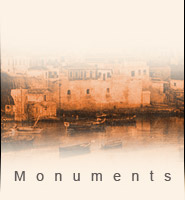



A number of entrances built into the town enceinte enabled communication between fortified Candia and the outside world. Depending on their use, these were classified as city gates, i.e. those which served the movement of goods and people in addition to defence, and strictly military ones for the exclusive use of the town guard, such as the Bethlehem Gate. Regardless of their use, almost all of these gates were situated near bastions or other strong points in the fortifications, so as to be adequately protected in case of enemy assault.
Equipped with a special guard and large wooden doors that opened at dawn and closed at dusk, gates in the first category (the St. George, Jesus and Pantocrator Gates) linked the town to the outlying country. A significant role was also played by the so-called shore gates, which secured communication between the town and the port and sea: the Harbour Gate, the Arsenal Gate, the Dermatas Gate, the Sampionara Gate and the St. Andrew Gate (the last of which were adjacent to the bastions of the same name).
Most of these entrances remained in use in the Ottoman period, up until the early 20th entry. The arrival of the first cars on the island then rendered the old Venetian gates inadequate; new entrances capable of catering for modern transport needs were then created, usually at a short distance from them.

Plan showing the gates in the enceinte, 2004 (Antonis Katzourakis, Multimedia Lab)









